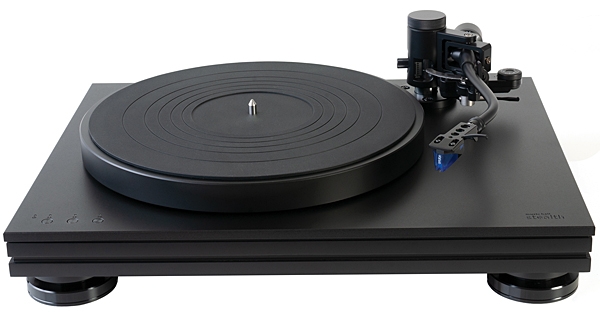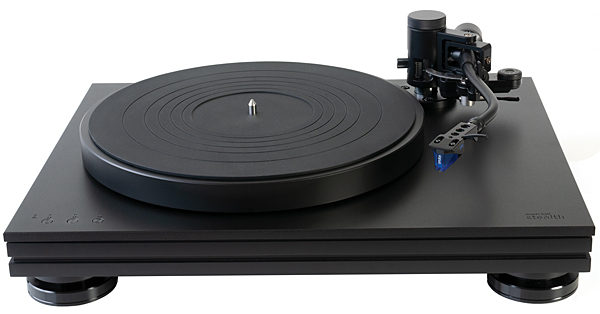
The next direct-drive turntable I know of is the solid-chassis Technics SP-10, which was introduced to recording studio and radio station markets in 1969. The SP-10 was quickly followed by Technics’s SL-1100, launched into professional DJ/ turntablist markets in 1971. This was followed by Technics’s SL-1200, introduced to home audio markets in 1972—which, coincidently, was the same year a Scotsman named Ivor Tiefenbrun launched his wood-plinthed belt-driven suspended subchassis Linn Sondek LP12 record player into Great Britain’s domestic audiophile market.
By 1975, Ivor in Glasgow had recruited legions of Brit-fi LP12 aficionados, and they were taking up arms and talking trash about direct-drive (DD) turntables, claiming that DDs were “noisy” and “couldn’t carry a tune.” Ivor claimed that DDs failed his toe-tapping “pace, rhythm, and timing” tests. The English-speaking audio press fell 100% for his belt-and-springs pontifications.
Hi-fi scribes cared little that built-like-a-tank, never-need-adjustment direct-drive ‘tables were quickly replacing rim and idler drives in recording studios and radio stations. Or that millions of the world’s young people were having no trouble tapping their feet (and dancing) to sounds derived from directly driven turntable grooves.

If the British press (or TAS or Stereophile in America) ever reviewed this “inferior” technology, I never saw it. Every reviewer I read said that a belt was a “necessary requirement” to “decouple” the platter from the vibrations of the motor. In 1992, there were no direct-drive decks in Stereophile‘s Recommended Components.
If I remember right, Goldmund’s Studio and Studietto were the first DD turntables to receive positive notice from audiophiles. Then, in 2007, Michael Fremer gave a “pretty good” AnalogPlanet review to Grand Prix Audio’s direct-drive Monaco. After that, he rave-reviewed the Brinkmann Bardo, also a direct-drive turntable. Then, in 2014, he canonized VPI’s Classic Direct Drive Signature. As far as I can tell, my 2015 review of the $799 Pioneer PLX-1000 turntable was the first Stereophile review of a truly affordable direct-drive deck.
Fortunately, anti-DD sentiments have lessened in recent years. Stereophile‘s Recommended Components now has four turntables in Class A+; two of them, the $363,000, American-made OMA K3 and the €180,000 (without tonearm), made-in-Sweden SAT XD1, are direct-drive models based on Technics SP-10R motors. (The other two are belt drives made by TechDAS in Japan.)

It pleases me that direct drive is finally making Stereophile star turns, but unfortunately, none are at the affordable end of the Recommended Components list, where I think DD naturally outguns belt drive, and where I imagined Music Hall’s new $1649 Stealth direct-drive deck might outplay its belt-driven competition. So, I was excited to try it.
Roy Hall, Music Hall’s proprietor-founder, is my favorite kind of person: a natural-born storyteller with a devious smile and a good pair of ears. But until now, I’ve had no reason to review a Music Hall product.
Now, though, I have the perfect reason. For 40 years, Roy has been a decorated general in his pal Ivor’s belt-drive army. For the sake of this review, I am choosing to regard his first foray into direct drive, the matte-black Stealth, as a white-flag turncoat product, maybe even a Trojan Horse that may or may not “carry the tune.”
Design and setup
Except for the white numbers on the tonearm controls and the Ortofon 2M Blue cartridge, Music Hall’s Stealth is black everywhere. In person, it looks austere and resolute, with little or nothing, stylewise, to suggest it’s a direct drive. (In contrast, Music Hall’s $249 us-1 turntable looks a lot like a direct-drive Technics but in fact utilizes belt drive.)
The Stealth is a three-speed, made-in-Taiwan turntable with a rear-mounted On/Off button and three small buttons on the plinth for selecting 33 1/3, 45, or 78rpm. It features a brushless, low-torque direct-drive motor mounted in what has been styled to look like one of Roy’s signature Sorbothane-MDF sandwich plinths, the ones he uses on his best belt drives. But, when I asked Roy in an email, “What is the exact composition of the Stealth’s sandwich plinth?” he replied, “Sorry but that is just a design feature. It is a solid plinth.” Listening to the plinth with a stethoscope, with the table running at 33 1/3rpm, I heard only the faintest motor noise, maybe 50% less than I hear from the two-motor belt-drive Dr. Feickert Blackbird.

The Stealth’s 4lb, viscous-elastomer–damped, die-cast aluminum platter is topped by a 1/16″-thick, slightly hard, slightly sticky rubber platter mat, which bugged me due to its propensity to attract and hold dust. For comparison, the mat on the original Technics SL-1200 (which I still have and now use on my PLX-1000) is 3/16″ thick, much softer, and doesn’t collect dust. The Stealth’s S-shaped aluminum tonearm sports a light, detachable headshell that does not allow for azimuth adjustment. The arm is specified to accept cartridges weighing 6–10gm—more when the included subweight is installed. Its thick cylindrical arm-pillar housing features a “window” for viewing the movements of the arm’s calibrated (in mm) arm pillar. At the top of this housing is a knurled, 1.5″-diameter knob that allows adjustment of VTA even while a record is playing. A thick, side-mounted lock nut secures the arm in place.
The Stealth’s tonearm exceeded my expectations: During use, it felt precise and well-sorted. Its bearings felt just-right tight, and its arm-lift mechanism served me with more ease and assurance than the one on my Schick tonearm.
Underneath the Stealth are four viscous-elastomer–damped, height-adjustable feet that effectively isolated the deck from footfalls and seemed higher in quality than I would have expected at this price point.
Interestingly, the MH Stealth includes an “auto shut-off” feature (also called “auto-stop”) that turns off the platter motor (but doesn’t raise the arm) after the cartridge spends 20 seconds riding the play-out groove. There’s also an “electricity saving” feature
that puts the deck into “auto standby mode” after 20 minutes of nonuse, and a motor-protection feature that turns the motor off if after 30 seconds it hasn’t come up to speed.
The Stealth comes with a fabric dust cover, a set of generic-looking RCA-to-RCA cables that I did not try, a 45rpm adapter that I used a lot, and the aforementioned cylindrical, screw-on subweight.
- Log in or register to post comments

The Barbarians were famous because their drummer, Victor “Moulty” Moulton had one hand, with the other, lost in a childhood accident, replaced by a hook. Their big break came when they were included in the T.A.M.I. show (which featured the Stones and James Brown). Their song, “Moulty” was basically a monologue by their handicapped drummer about how he kept positive despite the devastating injury. It came out years later that the backing band for “Moulty” was the Hawks (the Band) minus Levon Helm.

We returned to vinyl after a 30 year hiatus when my wife agreed that it would be a shame to waste the phono stage in the Luxman amp. I decided to look for a direct-drive turntable, hoping for a pretty much turn-key setup. It became clear quickly that the best prospects were one of the Technics or the Stealth.
Set-up was easy for the Stealth (no “hair-shirt audio” as Roy Hall commented elsewhere). It took me two tries to get the counterweight on the tonearm set properly, and a stylus gauge I had acquired helped with that. The Ortofon cartridge was pre-mounted correctly, and it was a simple plug-in to the end of the tonearm. Herb should have tried the supplied interconnect: I think it is well-constructed and tonally neutral.
The sound of the Stealth through the Luxman amp is marked by clarity with a touch of warmth. Channel separation can be startling good, and Airto Moreira’s percussion on an ECM pressing of the first Return to Forever album is riveting as the Stealth locks down the left-right image. My wife and I both enjoy the musical mind-meld between Chet Baker and Paul Bley on “Diane,” their album of duets on Steeple Chase. The first LP we played was John Coltrane’s “A Love Supreme” which proved an inspired choice as we start exploring vinyl again.
As always, your mileage may vary depending on your associated equipment and the sound you are trying to achieve. However, I doubt one can appreciably better the Stealth near it’s price point. Stereophile placed it with Class B in the latest Recommended Components, which strikes me as reasonable.

Hi
“Shame” or not depends on one’s music requirement.
I got donated many years back now sleeping in my junk bin: Luxman L-480 integrated amp (with phonostage of course), AM/FM tuner & a tape deck, all in Luxman then typical solud walnut wood housing & in pretty mint condition.
Yes, vintage Luxman audio can be good for family music recreation use.
BUT I would never want to use its phonostage for my LPs solely for sonic reason – way toooo vintage sounding let alone it being solid state, for my tube-spoiled ears.
Listening to tube is believing
Jack L

I can blame this only on geezeritus and too many blows to my head, but after the review was on the newsstands, I went to move the Stealth to the other side of the rack and realized that I had ONLY used the Music Hall supplied interconnect and its attached grounding wire.
Therefore all of my observations were made with the stock wire.
I apologize for the misstatement. .
herb

Hi
Yup, I heard quite a few hi-end affordable audiophiles back in Technic SL-1200 era when I was young young, complaining the music played on that DD TT did not “fly” – sound compressed & slacking.
Sounds similar to Ivor T’s comment: “could not carry a tune”.
Listening is believing
Jack L
PS: That said, my second TT on duty is also a vintage DD (made in Japan, but not by Technics) mounted with SME black carbon-fibre S-shaped tonearm/MMC cartridge of Japanese origin. I prefer playing my belt-driven TT though.
.
The Barbarians were famous because their drummer, Victor “Moulty” Moulton had one hand, with the other, lost in a childhood accident, replaced by a hook. Their big break came when they were included in the T.A.M.I. show (which featured the Stones and James Brown). Their song, “Moulty” was basically a monologue by their handicapped drummer about how he kept positive despite the devastating injury. It came out years later that the backing band for “Moulty” was the Hawks (the Band) minus Levon Helm.
We returned to vinyl after a 30 year hiatus when my wife agreed that it would be a shame to waste the phono stage in the Luxman amp. I decided to look for a direct-drive turntable, hoping for a pretty much turn-key setup. It became clear quickly that the best prospects were one of the Technics or the Stealth.
Set-up was easy for the Stealth (no “hair-shirt audio” as Roy Hall commented elsewhere). It took me two tries to get the counterweight on the tonearm set properly, and a stylus gauge I had acquired helped with that. The Ortofon cartridge was pre-mounted correctly, and it was a simple plug-in to the end of the tonearm. Herb should have tried the supplied interconnect: I think it is well-constructed and tonally neutral.
The sound of the Stealth through the Luxman amp is marked by clarity with a touch of warmth. Channel separation can be startling good, and Airto Moreira’s percussion on an ECM pressing of the first Return to Forever album is riveting as the Stealth locks down the left-right image. My wife and I both enjoy the musical mind-meld between Chet Baker and Paul Bley on “Diane,” their album of duets on Steeple Chase. The first LP we played was John Coltrane’s “A Love Supreme” which proved an inspired choice as we start exploring vinyl again.
As always, your mileage may vary depending on your associated equipment and the sound you are trying to achieve. However, I doubt one can appreciably better the Stealth near it’s price point. Stereophile placed it with Class B in the latest Recommended Components, which strikes me as reasonable.
Hi
“Shame” or not depends on one’s music requirement.
I got donated many years back now sleeping in my junk bin: Luxman L-480 integrated amp (with phonostage of course), AM/FM tuner & a tape deck, all in Luxman then typical solud walnut wood housing & in pretty mint condition.
Yes, vintage Luxman audio can be good for family music recreation use.
BUT I would never want to use its phonostage for my LPs solely for sonic reason – way toooo vintage sounding let alone it being solid state, for my tube-spoiled ears.
Listening to tube is believing
Jack L
I can blame this only on geezeritus and too many blows to my head, but after the review was on the newsstands, I went to move the Stealth to the other side of the rack and realized that I had ONLY used the Music Hall supplied interconnect and its attached grounding wire.
Therefore all of my observations were made with the stock wire.
I apologize for the misstatement. .
herb
Hi
Yup, I heard quite a few hi-end affordable audiophiles back in Technic SL-1200 era when I was young young, complaining the music played on that DD TT did not “fly” – sound compressed & slacking.
Sounds similar to Ivor T’s comment: “could not carry a tune”.
Listening is believing
Jack L
PS: That said, my second TT on duty is also a vintage DD (made in Japan, but not by Technics) mounted with SME black carbon-fibre S-shaped tonearm/MMC cartridge of Japanese origin. I prefer playing my belt-driven TT though.








